MILITARY HISTORY
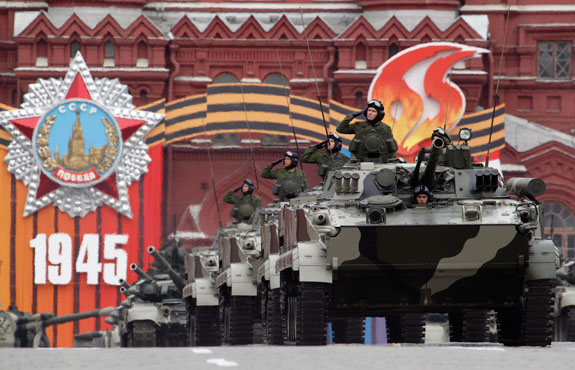
Reuters RTR2D1YR by AJ Sisco
Red Square May Day parade
Gouzenko to Gorbachev: Canada’s Cold War
J.L. Granatstein
Jack Granatstein, OC, PhD, one of Canada’s most renowned historians, has written extensively on Canada’s military history and defence issues. He was Director and CEO of the Canadian War Museum from 1998 to 2000.
For more information on accessing this file, please visit our help page.
Introduction
For Canadians, the Cold War was a matter of great importance—some of the time. For them, it began in September 1945 with the defection of Soviet embassy cipher officer Igor Gouzenko and revelations of major Soviet spy rings in Canada. Moscow’s brutalist policies under Stalin did nothing to ease growing concerns. Because they shared a continent with the superpower leading the democracies, their largest trading partner and ‘best friend,’ they soon found themselves living under the flight path for bombers and missiles from the Soviet Union, and that sharpened the collective mind and pushed them toward continued military cooperation with the United States. At the same time, Canada’s two mother countries, Britain and France, and nations such as Belgium, the Netherlands, and Italy that Canadians had fought to liberate, were under threat from what was generally perceived as an expansionist Soviet Communism. These and economic concerns led to a newly internationalist Canada being an enthusiastic supporter of a North Atlantic Treaty, and the first peacetime stationing of troops abroad. In Asia, the Hong Kong debacle of 1941 aside, Canada had never been active until the Korean War opened another front in the ‘Cold’ War. Again Canadians participated with troops.
Defence spending rose sharply in a booming economy, but very soon, pressures began to arise. There were widespread concerns about U.S. policy, Canadian nationalists and anti-Americans began to ‘kick against the pricks,’ and demands for expensive and expansive domestic social welfare policies led to pressures for defence cuts. By 1968 and the advent of Pierre Trudeau as prime minister, the calls for foreign policy change had become unstoppable, and until the arrival of Mikhail Gorbachev and the subsequent demise of the Cold War, Canadian policy was one of limited cooperation with Alliance partners, defence spending cutbacks, and planned military obsolescence. The Cold War if necessary, therefore, but not necessarily the Cold War, or, at least, not all Cold War all the time…
Beginnings
The Canadian view of the origins of the Cold War was stark and focussed. “The chief menace now,” Lester Pearson said in 1948, the year he left the foreign service to enter the Cabinet as Secretary of State for External Affairs, “is subversive aggressive Communism, the servant of power politics…Our frontier now is not even on the Rhine or rivers further east. It is wherever free men are struggling against totalitarian tyranny,” wherever the “struggle of free, expanding progressive democracy against tyrannical and reactionary communism was being fought….”1 Pearson had a subtle mind, but to him, the conflict was one painted in black and white. “Western democratic governments have no aggressive or imperialistic designs,” he said a decade later. “This is as true of the most powerful, the United States of America, as it is of…Iceland….Americans are not by nature or desire wandering empire builders….They are homebodies, and their ‘westerns’ give them an adequate if vicarious sense of adventure.”2 For remarks offered in 1958, these might charitably be described as naïve or at best hopeful, and Pearson knew better. On the other hand, when he was asked if it were better to be ‘dead than red,’ Pearson sensibly refused to agree, something that was used by political opponents to paint him as soft on Communism for decades.

Library and Archives Canada/Duncan Cameron/Duncan Cameron fonds/PA-212238
The Right Honourable Lester B. Pearson sitting at his desk, Ottawa, Ontario
Pearson had been shaped by his personal experiences. He had served overseas in the Great War, and as a young diplomat during the disillusioning 1930s. He had watched the democracies crumble in the face of the dictators, and, as a senior official, he had cheered as the United States had stepped forward—with substantial help from the British Commonwealth, and, especially, the Soviet Union—to save freedom and democracy. To him, to his generation of Canadians, the only way democracy could be saved from the new totalitarian threat was if the Americans, sometimes much too reluctant in Canadian eyes, could be encouraged to accept their responsibilities for world power. If they could, Canadians and others would participate in helping to create a Pax Americana. The involvement of the United States was the sine qua non in preserving the free world—that was an article of faith.
Canadians knew this, but as neighbours of the United States, they had their concerns. Britain’s economic and military weakness in 1940 and 1941 had forced Ottawa into its first military alliance with the U.S., the Permanent Joint Board on Defence (PJBD), created at Ogdensburg, New York, in August 1940. That meant that the growing Canadian armed forces could put all their efforts into the defence of Britain, sure that the United States would protect their home base. A few months later, Canada’s Mackenzie King struck an economic arrangement with Franklin Roosevelt that let Canada avoid taking Lend-Lease, something no-one wanted for fear of the future economic power this would give Washington over Canada. Instead, FDR agreed to cover Canada’s shortage of American dollars, the only hard currency in the world, in other ways, notably by buying more raw materials. The result was much the same. By the coming of the peace, Canada’s only postwar commercial market was the U.S., with virtually all of the nation’s trade with other nations being financed by Canadian loans and grants.3
Post-War Realities
Ottawa’s post-hostilities planners had watched carefully as the strains on the wartime Grand Alliance festered and developed over issues such as Poland. They understood that if they developed into open antagonism, Canada’s geographical position and economic situation meant that neutrality was not an option. Nor could Canada any longer rely upon Britain for protection. Canada had to be aligned with the United States. The Gouzenko case made this clear.
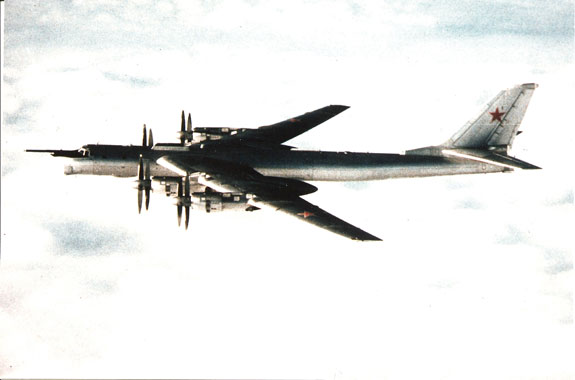
DND photo
TU-95 Bear
Igor Gouzenko fled the Soviet Embassy in Ottawa with a sheaf of carefully- selected documents just weeks after the atomic bombs brought the Second World War to its ghastly end. His telegrams and memos made evident that the GRU, Soviet military intelligence, had spies in Parliament, the Canadian civil service, and the military, in the British High Commission, and in scientific establishments, including those working on atomic research. Gouzenko knew of additional spy rings run by the NKVD, he told his interrogators what he knew of rings in the U.S., and his accounts eventually led to the outing of Alger Hiss, Harry Dexter White, and Julius and Ethel Rosenberg.4
Gouzenko mattered. First, his defection and his documents, made public in February 1946, and the subject of an extraordinary Royal Commission investigation, demonstrated that the wartime friendship between the Soviets and the West was over. Indeed, it demonstrated that Moscow’s war against the capitalist democracies had not even been put on hold during the struggle against Hitler. Second, for Canadians accustomed to being a backwater of little importance, Gouzenko demonstrated that Canada was ‘a player,’ a nation worth spying upon for nuclear and scientific secrets, as well as for details on British and American policy. Third, his documents showed that the assumptions of loyalty and trust that had been assumed to bind those working for government had been misplaced. Now, ideas and ideology had to be probed; now, positive vetting had to be put in place; now, character weaknesses began to be rooted out. It took time to implement this modest variant of McCarthyism, but before the end of the 1940s, some public servants’ careers had been ruined, and some had been hounded out of the bureaucracy.5 One diplomat, Herbert Norman, the Ambassador to Egypt, had been driven to suicide by ‘witch-hunting’ U.S. congressmen, convinced—correctly—that he had been a Communist, and fearful he might have been a ‘mole.’6 By the mid-to-late-1950s, homosexuals also had been singled out and forced from senior positions, not least in the Department of External Affairs.7 There was some irony in this. The Department of External Affairs, believing that Stalinist Moscow was a posting too dreadful for married diplomats with families, had sent three successive single men—all closet homosexuals—to Canada’s embassy in the late-1940s and early-1950s. All had been targeted by the KGB, apparently with only limited success.8

Canadian Press 7066130
Igor Gouzenko (centre) in a Toronto hotel room, 11 April 1954.
The Gouzenko case had altered attitudes, helping to shift Canadians away from their heartfelt admiration for the Red Army’s extraordinary fight against the Wehrmacht. The revelations of spying had been manipulated to point to a Communist and Soviet threat. To be sure, the Royal Commission report on the Gouzenko case was written in a reader-friendly way (by an officer from External Affairs), the press making much of it, and anti-Communists and anti-socialists using it as a weapon. But Gouzenko was not a Canadian creation. Moscow had committed the espionage—and it publicly admitted this, however unlikely that might seem. Moreover, Stalin’s acts in Eastern Europe and his representatives’ actions in various postwar forums hardly stressed eternal friendship. There is blame enough to go around with respect to the origins of the Cold War, but Canada has none, and Moscow, of the Great Powers, carries ‘the lion’s share.’9
Moving Along
Those in Canada who had anticipated that the new United Nations could enforce collective security on an unruly world had seen most of their hopes shattered within a few years by Soviet obstruction and the wielding of the veto in the Security Council. That was depressing enough, but Moscow’s pressure on Iran and Greece, its swallowing of Eastern Europe, especially the crushing of Czechoslovakian independence, and soon, the triumph of Mao Tse-tung’s Communism in China, made all deeply concerned for the future. Josef Stalin’s speech in Moscow in February 1946, one week before the Gouzenko case became public, declaring capitalism and Communism incompatible, and pointing to the inevitability of another war, added to the growing unease.10 What frightened Canadians and others silly, however, was the fear that Communist parties might come to power in free elections in Italy and France. The West, the democracies, had to be spiritually rearmed and made ready to resist the ‘Red tide.’ Perhaps, just perhaps, the democracies could create a new alliance for collective security to replace the veto-prone ‘talk shop’ that the UN had quickly become.
The first stage in this process was the Marshall Plan. The European economies lay in ruins, their cities shattered, food scarce and rationed, and the will to re-establish pre-war patterns of life not much in evidence. Only the Communist parties flourished, and the view in the U.S. State Department - and in Ottawa - was that only American aid could turn the tide. The United States had already stepped in to assist Greece, proclaiming the Truman Doctrine as the way to help a faltering government and to replace Britain, economically too impoverished by war and reconstruction, to continue its efforts there. On 5 June 1947, Secretary of State George C. Marshall told a Harvard University convocation that the European countries should create a collective plan for reconstruction, and he put a proposal for assistance before the United States. The road to Europe’s economic salvation had been discerned.
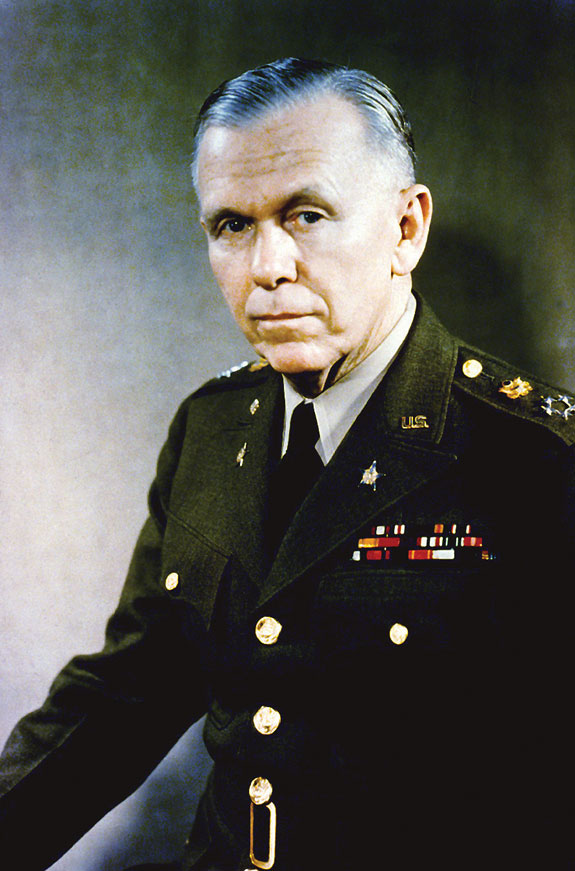
DefenseImagery.Mil DA-SD-05-00593
General of the Army George C. Marshall
Canada’s as well. Like the U.S. and a few other countries that had not been devastated by war, Canada had emerged in 1945 economically and politically far stronger than it had been when it went to war. The nation’s armed forces had fought well, and that conveyed prestige and power. Its Gross Domestic Product (GDP) had doubled, its industries boomed, and its well-fed people had money in the bank. But Ottawa knew this privileged position could not last without markets for the nation’s goods. The government had tried hard to re-build its British and European markets. A 1946 loan of $1.25 billion at two percent to Britain (especially when compared to the U.S. loan of $3.75 billion), and of $600 million to other trading partners was simply huge in Canadian terms,11 the country’s GDP being only $11 billion.
But American dollars, the world’s hard currency, again were growing scarce all over the globe. In Canada, the developing crisis was precipitated by soaring imports of everything from jukeboxes, to oranges, to consumer goods, as Canadians tried to spend the money that wartime wages and unlimited overtime had let them save. In 1947, Canada had no choice except to impose import restrictions upon American products to try to conserve its dollar supplies. The Marshall Plan, if the U.S. could be persuaded to allow ‘off-shore procurement’ in its provisions, could resolve much of the Canadian difficulty. France, say, which had too few dollars to buy Canadian goods, could pay with Marshall funds, and Canada would both sell trade goods and increase its holdings of American dollars. There was much struggle along the way, but off-shore procurement eventually ‘saved Canada’s bacon’ - and its wheat exports too - by authorizing purchases of U.S. $1.1 billion in Canada.12
But for a superpower supposedly poised to step in to save the world and scoop up the rewards, the U.S. - at least according to the way Canadian diplomats in Washington saw it - seemed remarkably reluctant to approve the Marshall Plan. Senators and congressmen objected to bailing out the Europeans, and, if they had to do that, then, they said, every penny must benefit American farmers and workers, not Canadians. Still, events drove the agenda. The Communists seized control in Prague in February 1948. The next month, General Lucius Clay, commanding the U.S. Zone in Germany, sent a message to Washington that seemed to suggest war with the Soviet Union was imminent. In March, President Truman asked Congress to implement conscription, and overseas, the Brussels Pact was signed, linking Britain, France, and the Low Countries. The Berlin Airlift soon began, with Canada declining to provide either aircraft or crews. The first preliminary discussions for a North Atlantic Treaty began. The drumbeats for war with the Russians were increasing in tempo. But Republican Senator Robert Taft and his isolationist friends still balked at American engagement in Europe, and Canadians feared the United States might yet fall back into its “prewar aloofness.”13
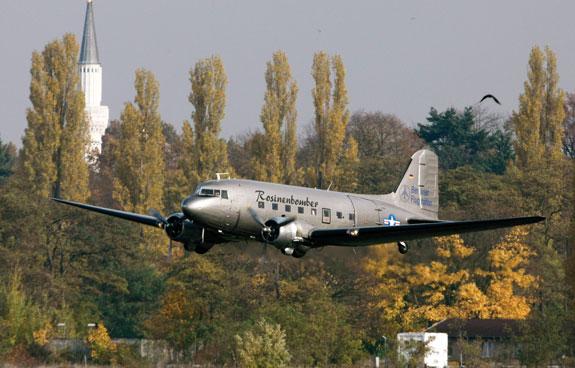
Reuters RTX9ZW9 by Fabrizio Bensch
A so-called ‘Candy Bomber’ DC-3 transport aircraft, one of the Allied aircraft beloved by West Berlin’s children for dropping bags of chocolate and raisins during the Berlin Airlift of 1948-1949, approaches Berlin’s Tempelhof airport, 28 October 1948.
Canadian Ambassador Hume Wrong, a man with a ‘steel-trap mind,’ and, as a lifelong friend of Dean Acheson, the very best of contacts in Washington, shrewdly observed in September 1947: “There is truth in the paradox that, to secure the adoption of a plan for world economic recovery, it is necessary to emphasize the division of the world between the Soviet bloc and the rest.”14 Frighten the American people, in other words. A few months later, the ambassador added: “The contest between the U.S. and the U.S.S.R. is providing the necessary popular foundation for a vigorous foreign policy and it has put those leaders who still possess strong isolationist leanings, such as Senator Taft and Speaker Martin, in the position of opening themselves to charges of lack of patriotism if they attack the general trend; they are therefore reduced to the role of critics of its details.” Wrong understood that the ‘whipping up’ of anti-communist hysteria was unfortunate, but perhaps inevitable in the American context. Certainly, such excesses were useful. For example, he reported to Ottawa: “… they are part of the price to be paid for the Marshall Plan.”15 Ambassador Hume Wrong and his colleagues (one of whom, incredibly, was named Hume Wright) had expressed serious concerns that isolationism might prevail. Most in Ottawa did not believe that war was imminent, but if the American Congress and people could be frightened into believing that it was…
Once again, this served Canadian interests. Canada’s leaders understood that their nation could not defend itself, and they accepted grudgingly that this realization meant the subordination of their policies and military plans to those of the United States. The Second World War had pushed Canada into a bilateral defence alliance with the Americans, a position that left Canada trying to deal all by itself with a partner fifteen times its weight. The war had also demonstrated that Canadian interests and concerns could frequently be brushed aside by the great powers. Now, if Britain and Western Europe could be brought into the equation, if the U.S. could be persuaded to join a permanent North Atlantic alliance, this would be good for the security of the West, and, by creating a new and strong multilateral alliance, certainly better for Canada than a purely bilateral relationship with Washington, in which it could only ever be a very subordinate partner. The Soviet threat facilitated the desire of Canadian leaders to have the United States, not all that enthusiastic as Ottawa and its diplomats perceived it, join a permanent military alliance and to take a multilateral rather than unilateral approach to the exercise of its powers and responsibilities. Ottawa’s goal, at once idealistic and self-interested, was to see American power exercised in association with Canada and other powers.

NATO photo 100415aHQ28.007
NATO flag
Enter NATO
Indeed, a trans-Atlantic alliance held out the possibility of resolving one of the great Canadian dilemmas. Norman Robertson, the Canadian High Commissioner in London and the most far-sighted of Canadian officials, wrote, in April 1948: “A situation in which our special relationship with the United Kingdom can be identified with our special relationships with other countries in western Europe and in which the United States will be providing a firm basis, both economically and probably militarily, seems to me such a providential solution for so many of our problems that we should go to great lengths… to ensure our proper place in this new partnership.”16 The North Atlantic Triangle was very much in Robertson’s mind.
The negotiation of the North Atlantic Treaty is a large subject. What needs to be said is that Canada, perhaps instinctively, as suggested by Robertson, sought to broaden the discussions to include economic clauses. Robertson was the initiator of the idea of Article 2 of the Treaty. How could nations unite for defence, he asked, if they fought trade wars against each other? How much better if the new alliance included a clause binding the parties “… to make every effort… to eliminate conflict in their economic policies and to develop to the full the great possibilities of trade between them.”17 A version of Robertson’s formulation eventually was included in the Treaty, a tribute to the negotiating skills of Ambassador Wrong in Washington. Lester Pearson noted that there were domestic political reasons behind Article 2: “We did not think that the Canadian people, especially in Quebec, would whole-heartedly take on far-reaching external commitments if they were exclusively military in character….”18 But no party to the Treaty other than the Canadians wanted Article 2, and the Americans, in particular, worried sick about what they saw as the almost insuperable difficulty of securing public and Congressional support for a peacetime military alliance, wanted nothing to do with a trade clause that might threaten the treaty for no important benefit. As Dean Acheson, becoming Secretary of State at the beginning of 1949 put it: “The plain fact … is that NATO is a military alliance.” Article 2, to him, was “… typical Canadian moralizing that meant ‘next to nothing.’”19 He was right, and Hume Wrong, the Canadian negotiator, knew it. For all the successful Canadian efforts, for all that Acheson began to characterize the Canadian demands as coming (with due deference to William Wordsworth) from “The Stern Daughter of the Voice of God.” Article 2, in the end, in fact, amounted to nothing.
War by another Name
Neither did the Canadian signature on the North Atlantic Treaty, at least not immediately. Signing on in April 1949, Canada did nothing very much to improve its armed forces, to rearm, or substantially to increase defence spending. The Defence budget in 1947 was $227 million, in 1948, $236 million, in 1949, $361 million, and in 1950, $493 million, satisfactory increases, but nothing to suggest urgency to create a great host. The Korean War, beginning in June 1950, changed everything, especially the Chinese intervention in December 1950 that drove the UN forces reeling to the south. The Communist attack, and the winter 1950-1951 defeat in Korea led to fears in Western capitals that the Soviet Union, now with nuclear weapons in its arsenal, was turning to military aggression to achieve its goals, and that Europe might be next. For Canada, that led to the dispatch of an army brigade group to Korea and a second brigade group and an air division of fighter aircraft, more than ten thousand troops in all, to Europe in 1951.20
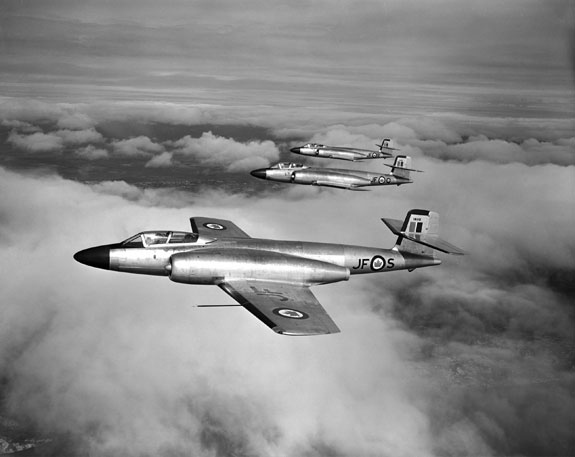
CFJIC photo PL-55486
Avro CF-100 Canuck interceptors on patrol.
At the same time as it was fighting on the Korean peninsula, for the first time in its history, Canada began to create an effective, well-equipped, professional military. Defence spending in 1951 was $1.16 billion; the next year, it was $1.8 billion or 7.5 percent of GDP, and in 1953-1954, the Canadian Forces, now with a regular force strength of 118,000 personnel, received $1.9 billion, or 7.6 percent of Canada’s GDP of just above $25 billion.21 Such figures were huge for Canada, but small beside the enormous sums Washington was devoting to defence.
Clearly, Stalin had made a huge error in giving Pyongyang the go-ahead to strike south. As Escott Reid, a senior External Affairs official in Ottawa and one of the originators of the idea of the North Atlantic Treaty, told a journalist friend, there were two key events that had saved the world: “... the intervention in Korea and the defeat of the U.N. army. Had it not been for these events, the West would never have faced up to rearmament,” he maintained correctly.22
At the same time, Canadian policymakers had real concerns about American leadership. Writing in May 1948, Pearson noted that, in the event of war, the United States would be the dominant partner, but, he said, if the Western European countries are not occupied, they will be able to make some effective contribution to the political direction of the war. “I have more confidence in the wisdom of their political views,” he said, “than in the wisdom of the political views of the United States….”23 NATO and the ‘police action’ in Korea had been designed to contain the Soviet Union. In Canadian eyes, however, containing the United States was also necessary, and disputes between Ottawa and Washington over the conduct of the Korean War, and the possibility of a negotiated armistice to end it, sometimes became very sharp. The Americans, bearing the heaviest burdens of the war, resented being told how the war should be fought by the Canadians, who had a single brigade and a handful of ships committed to the struggle. Pearson expressed the frustrations best in a speech in April 1951. The United Nations was not the instrument of any one country, and Canada had the right to criticize American actions, “… if we feel it necessary. The days of relatively easy and automatic political relations with our neighbour are, I think, over.” Now the Canadian concern was not “… whether the United States will discharge her international responsibilities, but how she will do it and whether the rest of us will be involved.”24
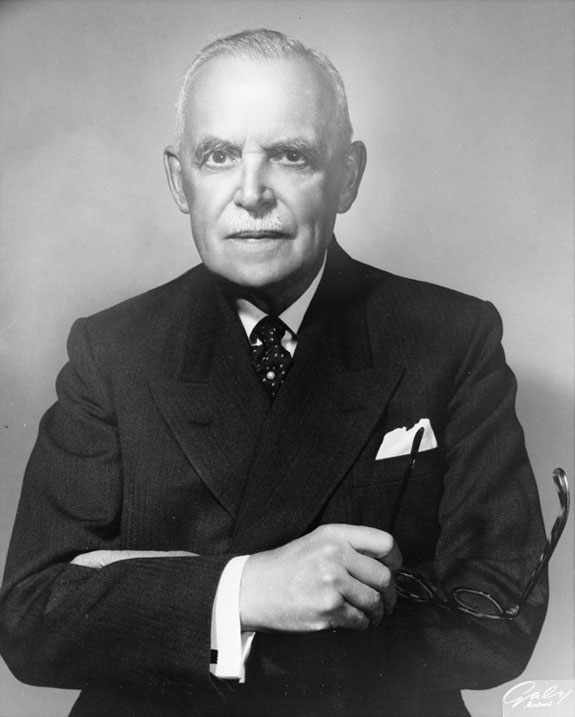
Library and Archives Canada/Gaby/C-00071
The Right Honourable Louis S. St. Laurent
Canada Steps Up
The Liberal government led by Louis St. Laurent, a francophone lawyer from Quebec City, that had taken Canada into NATO and Korea, was genuinely committed to the alliance and to the Cold War. For a francophone prime minister to act this way so soon after the manpower crises of wartime was highly unusual, and it demonstrated, to use one Australian’s acerbic description, that he was not, “… a neurotically-introverted, isolationist Quebecois,” a “millstone perpetually limiting Canadian freedom of action in strategic affairs.”25 Far from it: St. Laurent’s internationalist foreign and defence policies were not cheered in a Quebec that historically was suspicious of the military and of overseas commitments, but his French Canadian compatriots trusted his judgment, and gave him big majorities in three successive elections. To the prime minister, the Soviets and Mao’s Communists were a threat to Canadian and Western interests, and, indeed, all three mainstream political parties in Canada agreed with this stance with varying degrees of enthusiasm during the 1950s. Moreover, despite its general lack of interest in Asia, the Canadian government saw it as a duty to respond positively when asked—without any prior notice from the powers involved—to send military officers and diplomats to Indo-China in 1954 to serve on the International Control Commissions. This burdensome quasi-peacekeeping role later proved a blessing when the Vietnam War exploded into a major confrontation, and Canada could say that the ICC, continuing to work ineffectually while the fighting went on, prevented it from joining the United States in the war. As it was, Canadians on the ICC provided intelligence to the U.S., and the nation’s diplomats carried ‘carrot-and-stick’ messages between Washington and Hanoi.26
St. Laurent’s Canada believed that there were virtues in accepting reality. For one thing, despite opposition in Washington, it had been on the verge of recognizing Beijing when China intervened in Korea. It wanted to talk to the Soviets, and Foreign Minister Pearson was the first NATO leader to visit Moscow in October 1955, where he was abused roundly by Nikita Khrushchev for the sins of the West, while he and all his party ‘got thoroughly sozzled’ on the endless toasts offered by their hosts.27 And St. Laurent and Pearson worked hard at the United Nations to rescue Britain and France, mother countries and NATO partners, from the consequences of their folly in ineptly invading Egypt in collusion with the Israelis in the fall of 1956. As a Western power, as a member of NATO, Canada had a vital national interest in trying to repair the split between Britain and France, the aggressors, and the United States. Canada’s actions were directed as much to repairing the breach among allies, as to restoring peace in the area. Indeed, the two goals were positively inseparable. That the Suez Crisis occurred at the same time as the Hungarian revolt and the Soviets’ brutal intervention, that it took place during an American presidential election, only compounded the difficulties. Pearson won the Nobel Peace Prize for his efforts at saving the world and, not least, the NATO alliance, but the Canadian public, unhappy that Canada had turned its back on London and Paris, voted the Liberals out of power at the first opportunity.28

DND photo
The CF-105 Avro Arrow at roll-out, 4 October 1957, Malton, Ontario.
New Blood
The new Progressive Conservative Prime Minister, the lawyer and Prairie populist John Diefenbaker, was militantly anti-Communist. Unfortunately, he also proved to be virulently anti-American, falling into difficulties with President John Kennedy that turned primarily around nuclear weapons. In 1957-1958, Canada and the U.S. had created the North American Air Defence Command to combine and coordinate their air defences against Soviet bombers with their nuclear payloads. NORAD was readily agreed to by ‘the Chief,’ as he liked to be called, but this soon became the cause of political difficulty. Was it part of NATO, as Diefenbaker claimed, or was itnot, as the Pentagon argued? Then, in 1959, Diefenbaker cancelled work on the CF-105 Avro Arrow, much to his political cost, and instead decided to acquire U.S.-made Bomarc surface-to-air missiles to defend Canada and the northeastern United States against Soviet bombers. The Bomarcs, as well as newly acquired surface-to-surface Honest John missiles and CF-104Starfighter Strike fighters for the Canadian contingent in NATO, were effective only when armed with nuclear warheads. In 1959, no-one appeared to notice the warheads question.29 By 1962, however, Diefenbaker’s government, now a minority, began to be torn apart by the ‘nuclear yes/nuclear no’ question, and public opinion, pushed hard by peace groups, was divided, but still supportive of acquiring the warheads.30 The U.S.administrations of Eisenhower and Kennedy had watched angrily as Canada tried to scoop up the Cuban trade that U.S. companies lost after Fidel Castro came to power in Havana, and the Kennedy Pentagon was furious that there was a hole in their northern defences, while Diefenbaker delayed a decision with respect to accepting the nuclear warheads he had earlier wanted. Matters worsened dramatically during the sharpest crisis of the Cold War, when complete prime ministerial indecision during the Cuban missile crisis of October 1962 resulted in serious delays in putting Canadian interceptors inNORAD on alert. In fact, the Minister of National Defence (MND) acted on his own in ordering a full alert, while naval commanders put their ships to sea to shadow Soviet submarines on their own responsibility. The result, with White House approval, was the issuing of a press release by the State Department that delineated Diefenbaker’s wavering and parsed his speeches for inconsistencies and outright lies. Within days, the Cabinet splintered, the government fell early in 1963, and after a brilliantly mendacious anti-American campaign that almost carried the day, Diefenbaker was gone.31
More Changes
The new Prime Minister, Liberal Lester B. Pearson, accepted the nuclear weapons, and everyone expected continental harmony to reign anew. But soon, Kennedy was dead, Lyndon Johnson was in office, and the Vietnam War became messier. Some of Pearson’s ministers were every bit as anti-nuclear weapons and anti-American as Diefenbaker had been, the Finance Minister Walter Gordon in particular. Gordon wanted to cut the flow of American investment into Canada, failed in his efforts when Canadian businessmen and the U.S. government protested vigorously, and then he turned to the war. Pearson, in fact, had called upon the U.S. to halt the bombing of North Vietnam in a speech in Philadelphia in March 1965, a futile gesture that earned him Johnson’s contempt. “Here are the loyal Germans, always with us when it matters,” LBJ told a gathering of diplomats in Washington, “… and then there are the Canadians...” 32 Canada was not a totally compliant ally - had never been so - and Canadian nationalism, always drawing its strength from magnifying differences with the Americans, flourished. The nuclear stalemate, with its potential doomsday effects if war ever began, reinforced anti-Americanism in Canada, certainly more than it fed anti-Communism.
But Canada was still a ‘helpful fixer,’ ready to send in the peacekeepers when the West’s interests were at stake. In Cyprus in 1964, where Britain had bases and interests in a former colony, two NATO members, Greece and Turkey, were on the verge of war over the island they both wanted to control. Prime Minister Pearson initially was dubious about sending Canadian troops. “Let them cut each other up,” he told Paul Hellyer, his Minister of National Defence. “We certainly won’t go in just to help the British.”33 A war would have had disastrous effects on NATO’s southern flank, however, quite possibly destroying the alliance, and the Pearson government’s External Affairs Minister Paul Martin went to work on the telephones, calling foreign ministers around the world. The result was the establishment of a UN force. On 13 March 1964, Canada sent an infantry battalion, and UNFICYP, the United Nations Force in Cyprus, ‘hit the ground running.’ This served Canada’s desire to be a peacekeeper, already demonstrated in innumerable missions, but it also saved a critical part of the Western alliance, exactly as had occurred in 1956. Canadian foreign ministers from Pearson’s successor onward began to hope that, if they ‘called in their markers’ in the world capitals and at UN headquarters in New York, they too might create a peacekeeping force and help freeze a crisis. Then, perhaps, a Nobel Peace Prize just might come their way. After all, it had worked for Lester Pearson, had it not? Did not the Peace Prize help him become Liberal leader and then prime minister? ‘Nobelitis,’ Canadians called it, and not in an unkindly way.

Library and Archives Canada/Duncan Cameron/Duncan Cameron fonds/C-046600
The Right Honourable Pierre Elliott Trudeau – Prime Minister of Canada (1968-1979/1979-1984)
In the decade after Pearson’s Nobel Prize, as the Cold War continued, and as the United States became ever more embroiled in the morass of Vietnam, the Canadian public began to believe as an article of faith that peacekeeping was their métier. We were the world’s master peacekeepers, the indispensable UN players absolutely necessary for each and every mission. The Americans, always bumptious and too aggressive, fought wars, but Canadians, nature’s neutral middlemen, kept the peace. This became a mantra, a powerful idea that successive governments scarcely ever challenged. War was foreign to Canadian thinking, and peacekeeping was the natural role to play. For the public, peacekeeping was ‘do-goodism writ large,’ proof that Canada really was a moral superpower, loved by all. It was also a military role that differentiated Canada from the American focus upon nuclear deterrence and Mutual Assured Destruction (MAD). And if some worried that Canadians were not pulling their military weight in the Cold War, the easy answer was that the nation’s peacekeeping was useful, and it did not require huge armies, large fleets, and vast air forces. Governments liked that low cost factor. Being the globe’s pre-eminent peacekeepers was good for Canadian nationalism, peaking in a frenzy in 1967, the centennial of Canada’s creation, and, ironically, the year that President Nasser tossed UNpeacekeepers out of his country, much to Canadian chagrin, just prior to the Six Day War.
The Trudeau Era
This nationalism would reach another peak when the charismatic, stylish, 48-year-old bachelor Pierre Trudeau succeeded Pearson in the spring of 1968. Trudeau opposed Quebec separatism, and he was skeptical of nationalism in all its forms. He was a new man, the fluently bilingual quintessential Canadian, or so many thought in 1968. What Trudeau was, in fact, was typically French Canadian in his attitude to the military, to NATO, and to the Cold War. He was no isolationist, but he was not one to believe in the military, or one to want to take on the difficult global tasks that kept the peace. Puzzlingly, given his views on nationalism, he would become a nationalist icon in English-speaking Canada. Predictably, he would be the key figure in weakening the country’s support for the verities of the Cold War.
Trudeau was a trickster, always looking to shock. As a young civil servant in the Privy Council Office in Ottawa, he opposed Canada’s joining in the Korean War, or sending troops to Europe for NATO. Then, after leaving the public service, he had visited Moscow to attend an economics conference in 1952, telling everyone he was a Communist, something noted by U.S.Embassy officials. He also, at age 41, had tried to paddle a canoe from Florida to Cuba in 1960. Just good fun, his biographer said, as if the fellow-travelling Trudeau had been unaware of U.S. hostility to the new Castro regime.34 Both of those actions suggested he knew little of the United States, although he had spent a wartime year at Harvard, and perhaps that he was far from convinced that the Soviet Union was a major threat to peace, although Moscow’s repression of the Czech ‘spring’ occurred soon after he took office. He was scornful of Canada’s ‘helpful fixer’ approach to the world, and he claimed to want to shape Canadian policy from national interests.35
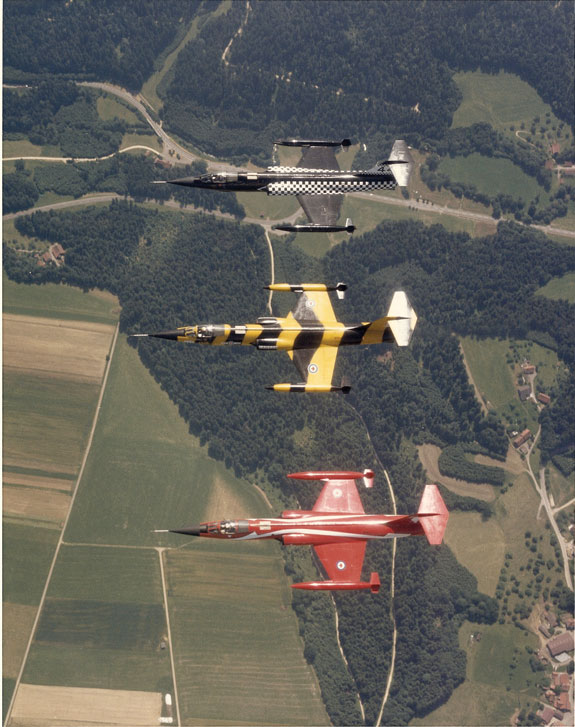
DND photo
Three CF-104 Starfighters, colourfully painted to represent, top to bottom, 441 Squadron, 439 Squadron, and 421 Squadron, thunder across the German countryside, circa 1983.
In fact, what Trudeau wanted was an end to Canada’s nuclear role, to get Canadian troops out of Europe, and to focus the Canadian public and policymakers upon domestic concerns, such as Quebec separatism. His efforts at reducing the NATO role came close to tearing his Cabinet apart in 1969. He and his ministers had examined all the options, among them, astonishingly, and ‘flying square in the face’ of geography, joining the non-aligned group of nations. Finally, the government announced a re-ordering of defence priorities, with NATO ranked third behind the protection of national sovereignty, North American defence, and just ahead of peacekeeping.36 Canada subsequently cut in half its NATO forces in Europe, and announced a phase-out of nuclear weapons. That was enough to gut the air force, and to turn the brigade group, well capable of ‘punching above its weight,’ and a key part of the NATO line in northern Germany, into a weak reserve formation in the rear. A man who had little regard for the military in general, Trudeau also cut the Canadian Forces by 20 percent to 80,000 personnel, and froze the defence budget at $1.8 billion. Ironically, when terrorism erupted in Quebec in October 1970, the military performed well in securing a volatile situation.
Trudeau epitomized the growing feeling in Canada that the Cold War had lasted too long, and it had distorted national priorities. For two decades, Trudeau said: “Canada’s foreign policy was largely its policy in NATO, through NATO.”37 That was no longer good enough. His government recognized China at last in 1970, and signed a Protocol on Consultations with Moscow, an agreement that Washington feared was a sign that Canada was sliding toward neutrality, a view shared by some in the Cabinet in Ottawa, which, extraordinarily, had not been consulted about the Protocol. As Trudeau put it in Moscow: “Canada has increasingly found it important to diversify its channels of communication because of the overpowering presence of the United States and that is reflected in a growing consciousness amongst Canadians of the danger to our national identity from a cultural, economic and perhaps even from a military point of view.”38In Moscow, such rhetoric sounded different than it might have in Moosonee, but most Canadian nationalists loved it. So did the Russians. He visited Castro in Havana in 1973, and shouted “Viva Castro” to end one speech. He visited Beijing in 1973 and expounded on the wonderful system Mao had given his people. It was little wonder that some in Washington believed Trudeau a Communist sympathizer. Then, in 1982, in a speech at Notre Dame University, Trudeau suggested that Canada was edging toward equidistance between the two superpowers, an astonishing comment from the leader of a nation almost wholly dependent for its defence and prosperity upon the United States.39 That was a mistake. Allan Gotlieb, Canada’s ambassador to Washington who accompanied Trudeau to South Bend, wrote in his diary: “The Americans…don’t like the notion that they and the Soviets are equally responsible for world tensions,” and, Gotlieb added, it offends the policymakers and the elites, “… people we can’t allow ourselves to alienate.”40
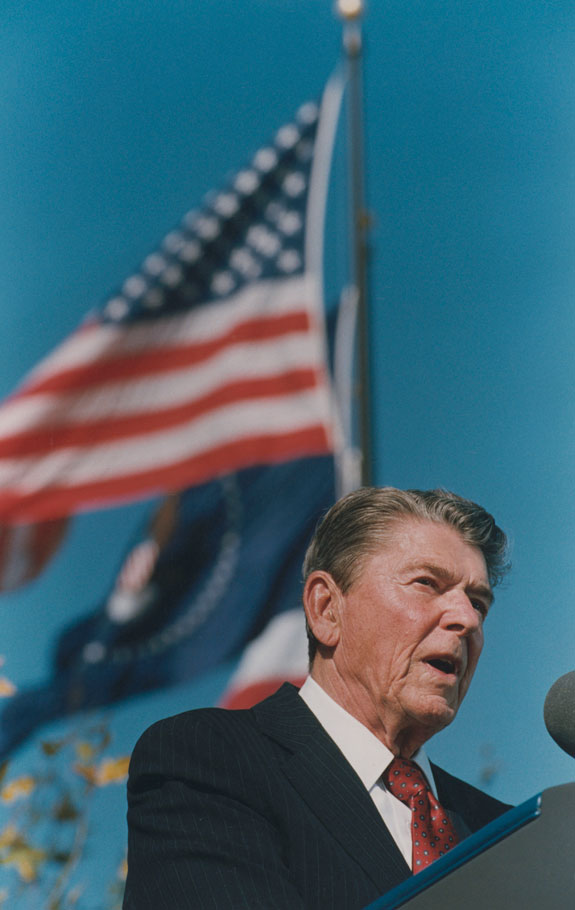
Reuters RTR15SJD by Gary Cameron
President Ronald Reagan
The period of détente, and the cooling of hostility between the West and the Communist world that Trudeau perhaps had some small part in fostering came to its end with the 1979 invasion of Afghanistan, the West’s subsequent boycott of the Moscow Olympics in 1980, and the Soviet shooting down of a Korean airliner in 1983. Trudeau’s response, his time in power coming to a close, was to launch a quixotic peace mission that entailed him travelling the globe, urging the nuclear weapons powers to reduce their arsenals. The Reagan administration distrusted Trudeau and his efforts, and one official at the Canadian embassy in Washington said the Americans “hated” Trudeau’s rhetoric that Canada was good, a peacemaker, and morally equidistant from the “naughty boys” with nuclear weapons. “A leftist high on pot,” one senior Administration official said undiplomatically after Trudeau’s visit to Washington on his quest.41 Ambassador Gotlieb noted in his diary that Trudeau “… is playing with other people’s marbles.”42
Nonetheless, Trudeau’s pitch to Reagan was not ineffective. “You are a man of peace,” he told the President in the Oval Office, “but your peace signals are not getting through.” Yes, Reagan said, “The press has distorted my image…”43 There were some signs that presidential rhetoric cooled after Trudeau’s visit, although no American officials believed Trudeau had anything to do with this. Overall, however, the peace mission had little effect. When asked about his impact some years later, however, Trudeau said, with a characteristic shrug, “Well, there was no war.”44 That at least was so.
Arguably, the most important formative role Trudeau played in easing tensions with Moscow was the friendship he developed with Alexander Yakovlev, Moscow’s ambassador to Canada. Urbane and intelligent, Yakovlev spent a decade in exile in Canada, punishment for his sins in calling for more effort to integrate Central Asian minorities into the USSR.45 In May 1983, Yakovlev arranged a ten-day visit to study Canadian agriculture for Mikhail Gorbachev, a rising Central Committee member. It was his first trip to Canada, and one of his few trips to the West, and Gorbachev reportedly was impressed by Canadian agricultural efficiency, and, said one Cabinet minister who escorted him around, by the quantities of food in and the opulence ofCanadian supermarkets.46 Demonstrating that he was something different than the usual Politburo hack, Gorbachev even appeared before a joint meeting of a House of Commons and Senate Committee, a ‘first’ anywhere. The Russian amiably sparred with the Canadian parliamentarians, parrying their criticisms with admissions that the Soviet Union was not perfect. None of the Members of Parliament or Senators ‘laid a glove’ on him.

Reuters RTXEV9W by Ian Waldie
Former Soviet Premier Mikhail Gorbachev
Trudeau also had lunch and dinner with the visitor, observing later that Gorbachev was the first Soviet leader with whom one could have a freewheeling conversation.47 The Canadian defended his own (very reluctant) decision to allow the U.S. to test cruise missiles over Canada, andNATO’s policy with respect to the deployment of missiles in Europe to counter Moscow’s SS-20 deployment. Trudeau told Gorbachev that, while he found President Reagan’s rhetoric distasteful, it would be a mistake to believe that Reagan did not reflect American public opinion. “Trudeau the hardliner,” wrote Ambassador Gotlieb in Washington. “Go figure.”48Gorbachev must have been puzzled that Trudeau had not behaved as his briefing notes portrayed him. Coming to power in 1985, the new Soviet leader brought his ambassador to Canada back to Moscow, and made Yakovlev, a proponent of glasnost (openness) and perestroika(restructuring), one of his key advisors as the Soviet Union began to change course.
End of the Era
The Cold War was not yet finished, however, but Trudeau was indeed finished. He departed in 1984, the Canadian public cheering him to the echo for his still-born peace mission. There was not much reason to cheer, either for the short-term results, or for the long term effects Trudeau had generated. Arguably, his prime ministership—with almost sixteen years in power—almost put paid to Canada’s American alliance. His quasi-neutralist attitudes had led the Americans to all but write off Canada as an ally. The formal alliance ties remained intact, and the efforts by the Canadian Forces to increase interoperability with their American counterparts did not cease. But the sense that there had been a community of interests, that both nations shared a similar sense of the world and its dangers, was gone. To the U.S., to Margaret Thatcher’s Britain, and to NATO, Trudeau’s Canada had seemed to be heading towards neutralism.
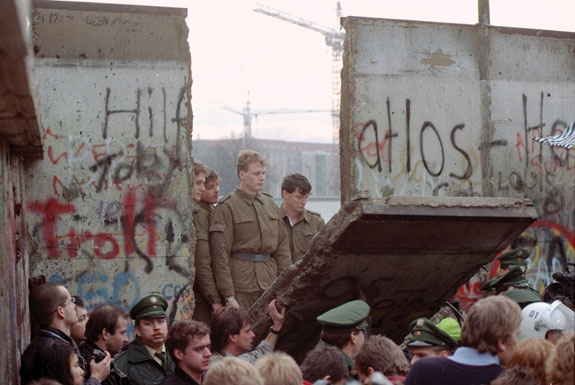
Associated Press 89111101329 by Lionel Cironneau
East German border guards look through a hole in the Berlin Wall after demonstrators pulled down a segment of it at
the Brandenburg gate, 11 November 1989.
the Brandenburg gate, 11 November 1989.
Matters could still change, however. John Turner, Trudeau’s lacklustre Liberal successor, lasted only months before losing an election. In charge now was the Progressive Conservative Brian Mulroney, an Irish Quebecker, smooth, charming, unabashedly pro-American, and desirous of “good relations, super relations” with Washington. Mulroney negotiated a Free Trade Agreement with the U.S., and won an election on the issue in 1988. He had also promised to restore the Canadian Forces, its equipment increasingly obsolete, its budgets constrained, and there were pledges aplenty made to the public and to the Reagan Administration with which Canada shared responsibility for North American air defence. But huge budget deficits constrained government actions. There were initially cuts instead of increases for the military, and by the time a bright young Minister of National Defence, Perrin Beatty, took over, the Cold War was drawing to an end. Beatty produced a Defence White Paper filled with sharp anti-Soviet language in 1987. Challenge and Commitment called for Canada to have a fleet of ten-to-twelve nuclear submarines ostensibly to protect Canadian sovereignty in the Arctic where American, French, British, and Soviet submarines roamed at will under the polar ice.49 But would Canadian submarines fire on the intruders? Would they try to sink the U.S. Navy ships? The idea of Canadian nuclear submarines, hugely expensive and sharply opposed by the Americans, who did not want to share their nuclear technology, yet feared Canada might acquire French power plants, ‘disappeared from the table’ as the Berlin Wall came down and the long Cold War drew to its end. So also did Canada’s commitment to the defence of Western Europe. Without consulting their NATO allies, the Conservatives in 1992 announced a total withdrawal of Canadian forces from Europe, a process completed in July 1993 at a projected budgetary saving of $2.2 billion. Canada was now committed, but not present, insofar as NATO was concerned.
In fact, Canada had been committed but not psychologically present to the defence of Western Europe, and, indeed, of North America for years. The peace dividend had been cashed in and spent since Trudeau’s NATO cuts of 1969.
Summing Up
Three streams of opinion shaped Canada’s Cold War: internationalism, continentalism, and nationalism. The diplomats, and some of the politicians who took Canada into the Western alliance, were internationalists who believed this was the way to foster a sane nationalism. They were aware, however, that Canada’s economic prosperity and its defence ultimately depended upon the United States, and the scarcity of American dollars and British economic weakness drove Canada southward. So also did Canadian business’ desire for rich, easy-to-serve markets, and a shared North American view of the world. Canadian nationalism, exemplified by John Diefenbaker, and especially Pierre Trudeau, however, looked upon the costs of defence with a wary eye, and resented the United States for the way it sometimes bullied the Dominion. Diefenbaker fought with President Kennedy and was toppled. Trudeau wanted a Canadian foreign policy that served the national interests and peace, but he never appeared to understand that Canada was attached physically, economically, and militarily to the United States, and could not act as if it were an island. All Canadian leaders from Louis St. Laurent onward focussed upon peacekeeping, which sometimes served the interests of the Western alliance. But peacekeeping, because it alone was popular with the public and came to form a key component of Canadian nationalism, ultimately put paid to the nation’s psychological participation in the Cold War long before its end in Soviet collapse.
Curiously, however, it was continentalism that achieved dominance among the competing Canadian ideologies. By the end of the Cold War, a free trade agreement with the United States was in place, a huge proportion of Canadian trade went south, and U.S. corporations operated everywhere in Canada. That anti-Americanism was the key component of Canadian nationalism could not hide the reality of almost complete integration; nor could Canadian internationalism, strong among youth and NGOs, dispel the fact that Canada, from the 1960s to the turn of the century, received scant regard from its friends abroad, and none from its enemies. Canadians had forgotten that both reliability in foreign policy, and the ability to deploy force when necessary mattered. They had even forgotten that the ability to defend their own people and territory is the essential national interest for every nation-state. National interests have always mattered, and they still do.
No comments:
Post a Comment
Comments always welcome!